Tendulkar represented the modern right-handed cricketing greats in recent timesLeft-handed batsmen bring a certain flair and sense of style to the game of cricket. What makes it even better is the presence of the opposite side - the right handed section, a more common sight seen in the hallowed portals of the Gentleman’s Game across all formats.This unit, comprised of a bunch of extremely skilled individuals, are alike, and yet not so alike, in the manner in which they utilize the skill sets at their disposal.One set of right-handers is the slam-bang kind, gaining much more prominence in today’s lightning quick Twenty20 era. Their only mantra is to hit the ball out of the park or send it clattering over the boundary ropes.Some are labelled sloggers; yet there is a smaller subset whose style of play, though in the attacking mould, has a certain sense of refinement in savagery. The likes of Sir Viv Richards, Virender Sehwag, Glenn Maxwell, Kevin Pietersen, Herschelle Gibbs, etc. fall into this category. Another set of Northpaws (An adjective I coined to distinguish them from Southpaws or left handers) is the kind that focuses on building & consolidating an innings. When you lose early wickets up front, you need someone with nerves of steel, immense concentration & the ability to navigate the side out of troubled waters.Although I haven’t included him in this list (not because he’s a better Test player than in the limited overs format), the quintessential epitome of this breed of cricketers is Rahul Dravid, though players such as Mahela Jayawardene, Nasser Hussain, Steve Waugh, Carl Hooper, etc. have also done similar jobs for their respective nations. Putting together an elite list of eleven players who are purely right-handed in cricketing terms is a Herculean task, especially since the conditions remain the same as the ones laid out in my article on pure left-handers - batting & bowling right-handed, while wicket keepers are irregular bowlers.For those who were expecting me to keep the Wall in this list, apologies in advance; it is very difficult to keep out legends from any playing XI. Again, this squad includes those who have retired post the 2003 World Cup & its subsequent editions.
#1 Sachin Tendulkar (India - Opening batsman)
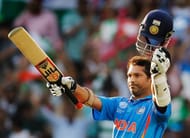
In cricket, you come across individuals who not only have prodigious talents but also utilize them to the fullest. These guys have long had the habit of polishing and refining their craft, unfazed by injuries, the vagaries of age, and keeping a child-like enthusiasm alive for a long time.
Twenty-four years of international cricket, 463 ODI matches, over 30,000 runs scored across Tests, the 50-over format, first-class & List A cricket - Sachin Ramesh Tendulkar has truly become the global ambassador of the modern game. It, therefore, is not surprising that he occupies the first opener’s slot - a spot he had made his own for India in the coloured flannels version of the game.
Although he is cross-dominant (writing with his left hand), the Mumbai maestro has been called the most complete batsman in the history of cricket. He’s a rather unique combination: blending in classical technique with raw aggression is an ability few have mastered over the years.
The backfoot punch, the straight drive, the paddle sweep and the trademark flick to square leg - all of these bear the hallmarks of long hours spent in the nets, on hard dusty bowls in the subcontinent, and the fast, bouncy tracks on offer overseas.
Adept at reading field placements and bowlers’ minds, Tendulkar has been the architect of many famous victories for the Men in Blue. It was thus befitting, for a player of his stature, to achieve the distinction of becoming the first male cricketer to score a double century in ODI cricket - a feat repeated by his protege Virender Sehwag and twice by the younger Rohit Sharma.
His mastery of the Australians in Sharjah is still a vivid memory in the minds of his die-hard fans. For someone who once had ambitions of becoming a fast bowler, the Little Master is more than a handy bowler, with his unique mixture of seam, leg spin and off spin, and he has the knack of picking wickets at crucial intervals.
This odd yet potent concoction has resulted in the collapse of the opposite lineup many times. A fine fielder in the deep, Tendulkar is truly the man you would love to have at the beginning of the innings!
#2 Hashim Amla (South Africa - Second opener)
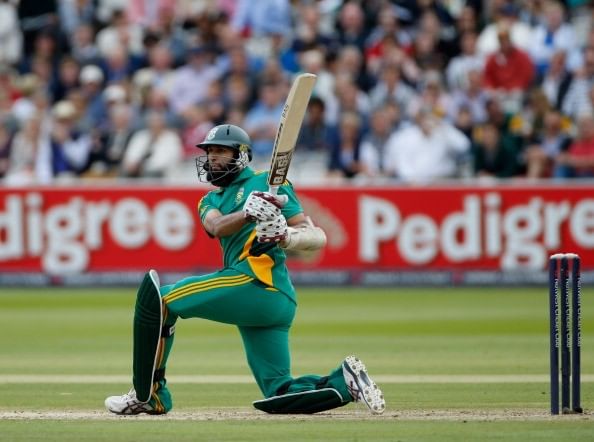
Hashim Amla is a rarity in the current South African ODI setup. Ever since veteran Jacques Kallis hung up his boots, the bearded, Indian-origin right-hander has certainly taken huge strides in filling the void left by the talismanic all-rounder.
Another player in the Rahul Dravid mould, the Proteas Test skipper has been making waves in the ODI format of late, with his innate ability to place the ball, sheer timing and quicksilver footwork against the spinners.
There is a preternatural calm in the Tongaat native’s batting. You rarely see him hurl expletives at opposition players, or get flustered and try to smash the ball out of the park very early into his innings.
He prefers to bide his time, sizing up the situation and keep the scoreboard ticking before unfurling his signature shots all over the wicket. Exquisite is the adjective I’d use to describe those wristy leg-side flicks, perhaps a nod to his Indian roots.
It is this monk-like patience that has seen a rebirth of the 32-year old in the 50-over version of the game. India couldn’t get him out in the two-match Test series in 2010, and even New Zealand struggled to rein in his fluid, classical strokeplay in 2014.
With his amazing brand of cricket and a determination to put huge price on his wicket, the South African stalwart provides a perfect foil for Sachin Tendulkar at the top.
#3 Virat Kohli (India - Street fighter at no. 3)
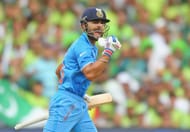
Former England captain Nasser Hussain once labelled Kiwi all-rounder Scott Styris a street fighter due to his pugnacious style of play & tenacity. Indian Test captain Virat Kohli can lay claim to the epithet in the modern version of the game.
Naturally aggressive and highly instinctive, the Delhi batsman has certainly lived up to the expectations that any prominent member of the Blue Brigade must carry in international cricket.
Quite a few times, his brash attitude has landed him in hot water with the authorities, but Kohli the cricketer is slowly maturing into a leader, and the on-going metamorphosis is remarkable.
Blessed with a wonderful technique (although it has caused him a lot of trouble in limited overs recently), the 26-year old prefers to play on the front foot, and is equally strong on the backfoot play as well.
Favouring the areas between midwicket and square leg for his scoring shots, the right-hander is also an exponent of the cover drive - a shot he considers to be his favourite, along with the flick. His footwork, too, is quite impressive, and his ability to keep a calm head in tough situations such as chasing tall scores has bailed his side out on many occasions.
2012 was a phenomenal year for the young dasher, as he spearheaded his team’s successes with a temperament that belies his young years. He is also one of the few players to score a century on World Cup debut (in 2011); his partnership with fellow Delhi batsman Gautam Gambhir proved to be just as instrumental as MS Dhoni’s finishing touches in the final at Wankhede.
Also, not many batsmen around the world have taken on the fearsome Lasith Malinga with nonchalance - Kohli’s innings at Hobart simply radiated authority over the Sri Lankan slinger. His 183 against Pakistan is also the stuff of legend - it’s always great to go one over the arch rival, isn’t it?
Quick on his feet and a very speedy mover on the field, Kohli forms a magnificent partnership with Suresh Raina, Rohit Sharma and Ajinkya Rahane as the quartet effectively saves a lot of runs for their side with their athleticism.
A part-time military-medium bowler, and one whose leadership abilities at 20 secured India the U-19 World Cup in 2008, the Delhi superstar is definitely the captain India would do well to have across all formats in the near future.
#4 Jacques Kallis (South Africa - Sheet anchor at no. 4)
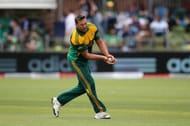
Regarded as one of the finest all-rounders to have played the game, former South African stalwart Jacques Kallis is one of those remarkable talents to have served their nation with distinction over a long period of time.
The burly Cape Town resident has not only garnered praise from his teammates at each level but also cemented his spot in the annals of the all-time legendary greats of the game. It is an achievement befitting a man who has been the mastermind of some of South Africa’s greatest triumphs.
Nothing about Kallis’ batting style hints at flair nor does he indulge in playing to the gallery. It is a compact, rock solid technique - orthodox and one that many felt was more suited to white flannels than to the shorter versions.
He has mastered the flick off the hip - a sometimes dangerous stroke to play against genuine pace - and his cover drive would make the likes of Sachin Tendulkar & Rahul Dravid proud. He lends dependability to the middle order in this team, as the true art of one-day cricket lies in consolidating an innings - an art in which Kallis is a master.
The 1998 Mini-World Cup in Dhaka was perhaps his finest hour, as the then 23-year old would go on to become a vital part of the Proteas. A strong, powerfully-built man, the all-rounder can be a handful with the ball, with accuracy and swing being his chief weapons.
He can break threatening partnerships, and is reliable in the slips or in the outfield as well. Though the majority of his career was spent batting at no. 3 for the Rainbow Nation, his solid nature brings much more of a strong platform at no. 4 in this team.
#5 AB de Villiers (South Africa - The refined maverick at no. 5)
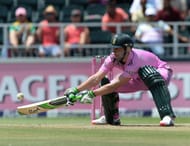
In the true sense of the word, Abraham Benjamin de Villiers is an all-rounder. After all, he not only excels in the Gentleman’s Game, but also has demonstrated considerable skill in golf, rugby, badminton, swimming, tennis and hockey (the last named sport evokes comparisons with the illustrious Jonty Rhodes).
In cricketing terms, the Pretorian has batted, bowled, fielded and even kept wickets for his side. What team wouldn’t love to have him? His exploits with the willow have been, quite literally, out of this world.
Many unorthodox strokes, some pioneered by other batsmen, have in fact received added attention when played by De Villiers. Words like audacious, outrageous, awesome, etc. have been liberally used whenever he unleashes any of those strokes.
It is this unpredictability that makes De Villiers very dangerous; his wicket-keeping tenure has given him an insight into field placements, and he has often used that to his advantage when clearing the ropes at will.
Tillakaratne Dilshan fashioned the Dilscoop, Kevin Pietersen brought out the switch-hit - De Villiers possesses the reverse Dilscoop as well in addition to these two shots. Such are the abilities this man has that it is difficult to nail down a particular position for him in the batting order.
I’ve put him in at no. 5 because he can play the role of the finisher in such a brutal fashion that the rest of the opposition can be rendered as unwilling to continue the game. The West Indies certainly felt that in the 2015 World Cup, when the Proteas skipper broke numerous batting records with a single innings that re-affirmed his standing as one of the all-time greats in the limited overs format.
He is an amazing fielder, effecting run outs and direct hits at the drop of a hat. The Australians have seen this from close quarters - Simon Katich’s dismissal in a 2006 game still reverberates through their minds.
It certainly ranks right up there with Rhodes’ acrobatic dismissal of Inzamam-ul-Haq in 1992. Bewildering opponents and delighting fans across the world with his unorthodox repertoire, De Villiers is the perfect man for the job at no. 5.
#6 MS Dhoni (India - Captain, wicket-keeper and Mr. Cool at no. 6)
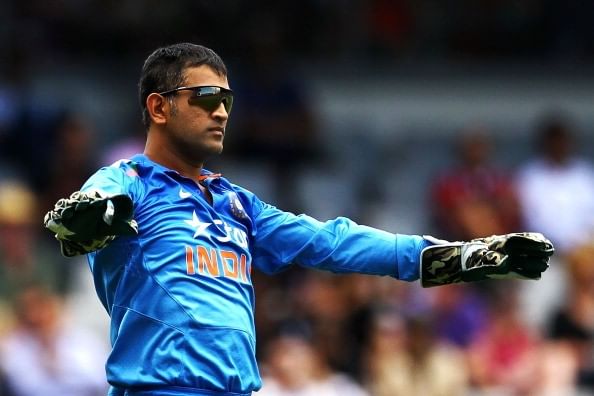
In all fairness, I think that the Jharkhand lad is still a great leader. His recent travails notwithstanding, Mahendra Singh Dhoni is not someone who will succumb to pressure-cooker situations very easily. Neither does he possess the classical technique expected of a right-handed batsman.
The way he wields the willow reminds one of a young warrior facing off against numerous opponents with only a broadsword for a weapon - ungainly best describes the way Dhoni bats. But there is absolutely no doubt that his ‘ugly batting style’ is highly effective.
Starting off in international cricket as a powerful striker of the ball, the wicket-keeper has blossomed into a seasoned, battle-hardened, composed statesman who has the unique ability to soak in all that the opposition throws at him, and then engineering many a great escape.
When he sent the hapless Lankan bowlers on a leather hunt at Jaipur in 2005, the world felt that India had finally found an answer to the problem of a glovesman who could bat well, and play the big shots.
It took a disappointing 2007 World Cup to bring out the leadership abilities of Dhoni, and he turned around India’s fortunes with a phenomenal victory at the inaugural Twenty20 World Championships. In keeping with this elevation, he also tempered his uninhibited strokeplay, focusing instead on pacing the innings and bringing it to a successful close.
He still has the penchant of landing a huge hit right when the team expects him to do so, and can effectively farm the strike or rotate it at will. Captaincy made him more aware of his responsibilities - his win percentage is definitely something to be proud about.
Dhoni has been accused of letting the game drift at times, but several of his gambles have paid off handsomely. Behind the stumps, his glovework and quick anticipation is still quite commendable, and his reflexes are still there despite being on the wrong side of 30.
As a grafter who can provide the impetus at the close of the innings and a calm leader who can marshall his troops well, the Indian limited-overs skipper is my preferred candidate at No. 6 - it’ll be a treat to watch both him and AB de Villiers smash the bowling to smithereens towards the end of the innings.
#7 Shahid Afridi (Pakistan - Boom Boom at no. 7)
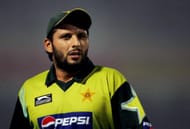
One of the cardinal rules to be followed when Shahid Khan Afridi is at the crease is to never make him angry. It unleashes a side of him that is very detrimental to the opposition’s cause - and sometimes, to his own side as well.
Give him an inch, and he’ll convert it into a hundred miles with such ferocity & speed that makes your head spin. Age might have tempered his aggressive batting to a large extent, but Afridi is one of those high-impact players who can never be out of the spotlight in the game.
His playing style has always been suited to limited-overs, because it gives him the license to go on an all-out, kamikaze-style attack on the rival bowling. Never has the cricketing world seen a player who hit the ball with so much power and fearsome regularity than the burly Pathan.
The cross-batted flick to the leg side is a particular favourite of his, and arch rivals India faced it many times during the series in 1998-99. Out of the six fastest one-day hundreds, Afridi has scored two - the first of which stood for almost 18 years. But because his all-or-nothing approach results in quick dismissals, he has been frequently shunted up and down the order.
At no. 7, he has the full freedom to go for his shots - a quick 30 or 40 later in the innings is always a major differentiating factor between a win and a loss, and this is where I’d choose him to play.
With the ball, Afridi is highly effective as a leg-break bowler, capable of taking wickets with his mix of quicker ones and the conventional off-break. Having started off as a fast bowler who switched to spin because it was felt that he was susceptible to throwing, he became one of Pakistan’s key strike bowlers, as evidenced in the 2007 World T20 as well as in the 2011 50-over World Cup tournament.
A memorable haul of 7/12 against the West Indies two years ago served to underline his importance to the 1992 world champions. His all-round capabilities make a vital pick in this side.
#8 Brett Lee (Australia - Searing pace at no. 8)
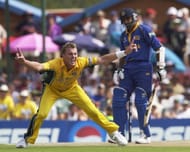
Known for his blistering pace at the beginning of his career, former Aussie pace spearhead Brett Lee has been one of the greatest bowlers in the modern form of the game. Well-built and extremely athletic, the New South Wales bowler formed a potent strike pair with veteran Glenn McGrath that terrorised batsmen across all the Test-playing nations.
Although persistent injuries have forced him to rely less on speed, he has developed many variations that made him the true successor to the Australian bowling greats after the 2007 World Cup.
He does have the capacity to bowl full overs at around 150 kmph, and his clever use of slower deliveries, short balls and the toe-crushing yorker have made him a feared opponent. Because a pacer of his speed & calibre has to bowl long spells, he has often been subject to stress fractures of the lower back.
Nevertheless, he was one of Ricky Ponting’s chief weapons during Australia’s successful defence of the 2003 and 2007 World Cups, delivering when it mattered. A hat-trick against Kenya and a five-wicket haul against the Black Caps in the 2003 edition serve as testament to his mastery over the art of bowling fast & furious.
A competent lower-order batsman, Lee has participated in some of Australia’s key wins where he has used the long handle to good effect. With former teammate Glenn McGrath and New Zealand’s speed merchant Shane Bond for company in this squad, the affable paceman fills the No. 8 slot with considerable aplomb and the sporting spirit.
#9 Shane Bond (New Zealand - Fast and Furious)
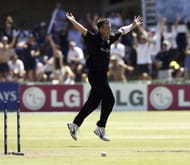
His body never did hold up well for him to have a prolonged playing career. Involvement with the rebel Indian Cricket League also curtailed his international sojourn to a fair extent. But former New Zealand fast bowler Shane Bond was never short of talent or skill, and he demonstrated his abilities in the few opportunities he had owing to the aforementioned issues.
A fierce competitor on the field, the former policeman was the Black Caps’ best ever quicker bowler since the great Richard Hadlee and served ample proof of his abilities in that area.
Tall and possessing fearsome pace at the beginning of his career, Bond combined speed with immaculate accuracy and remarkable control, even at a fairly young age. Canterbury were well served by his talents in the domestic competition, and an international call-up wasn’t far behind.
His finest performances were always reserved for trans-Tasman rivals Australia; his five-wicket hauls in January 2002 and in the World Cup a year later exerted a dominance over the world champions that no single bowler had ever managed in a long time.
Also, in one of his many comebacks from injury and with a remodelled action, he wrecked the much-vaunted Indian lineup with a devastating spell of 6/19 while defending a relatively small total of 216. His unerring accuracy is a bowler’s trademark - he could choke the flow of runs with such ease that batsmen were forced to go on the defensive more often than not.
Some skill with the long handle is quite necessary in the lower order, and Bond is capable of tonking a few big ones quite handsomely. With pace rival Brett Lee for company, the Christchurch speed merchant is going to be a force to be reckoned with.
#10 Muttiah Muralitharan (Sri Lanka - Wily spinner)
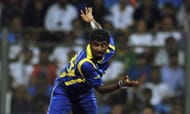
For someone who was repeatedly no-balled in Australia in 1995, Muttiah Muralitharan has come a long way. It was a congenital defect of his arm that led to hyper-extension, thus casting a lot of doubt in the minds of umpires, match referees and spectators alike.
But there is no denying the fact that the Lankan off-spinner was the best in his field, and his achievements have their own place in the history of the game.
The first-ever wrist spinner to bowl off-breaks, Muralitharan’s rather unorthodox action sometimes confused batsmen for being similar to that of a leg spinner - former Australian captain Allan Border was one such player.
His bowling stance is slightly open-chested, allowing him more freedom to stretch his bowling arm & release those unplayable deliveries. He has also mastered the doosra - the delivery that turns from leg stump to the off stump, beating the bat all ends up.
Throughout his career, the wily slower bowler has had many duels with the likes of Sachin Tendulkar, winning quite a few. His magical spell of 7/30 against the 1983 world champions is yet unmatched by any spinner.
He’s not the most orthodox batsman around, to be honest. Having spent most of his career at no. 11, his tendency is to back away to the leg side and slog. Nevertheless, he does manage to score a few boundaries, and can hang around for a while if needed. It is his bowling that is his chief strength, and that wins him a place in this squad.
#11 Glenn McGrath (Australia - Relentless accuracy)
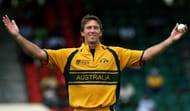
Nicknamed Pigeon for his lanky frame, former Australian seamer Glenn McGrath was not the quickest going around. His key strengths were a focus on line & length, and pinpoint accuracy.
Combined with his height and a high-arm action, he was able to extract bounce from the flattest of tracks, surprising many. Indian batting great Sachin Tendulkar has often been dismissed by the NSW swing bowler, although the former has also responded with some of his best innings against McGrath’s Australian side.
A competent outfielder, the Dubbo native was not quite as athletic as Ricky Ponting, but he did have his moments in the field - an exceptional catch to dismiss Michael Vaughan in 2002 stands out.
He also possessed a fine throwing arm and was hence regarded as a fair fielder outside the 30-yard circle. His only limitation was with the blade, although sessions with former captain Steve Waugh helped to reduce it to a great extent.
Although he was renowned for sledging opposition batsmen, it is his ability with the ball that helps him make it to this playing XI.
Brand-new app in a brand-new avatar! Download CricRocket for fast cricket scores, rocket flicks, super notifications and much more! 🚀☄️
